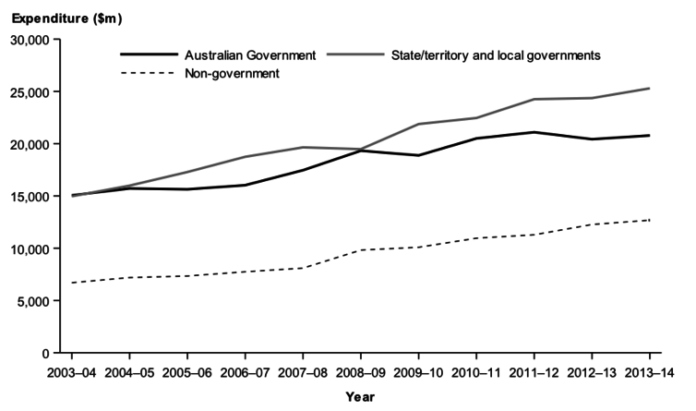The Council of Australian Governments (COAG) will today consider a proposal from the Prime Minister to give additional funding to the states for public hospitals.
The Commonwealth is partially reversing cuts it made to public hospital funding in its 2014 budget, offering a new A$3-5 billion three year deal. But the deal has some unwelcome strings attached and does not meet the funding gap created by the 2014 cuts.
The history
Hospital funding has long been the subject of acrimonious and unedifying funding disputes between the federal and state governments.
The first one of these occurred in 1976, just one year after Medibank – the precursor to Medicare – was introduced. In a saga strangely similar to what ran 30 years later, a Liberal government had promised prior to the election to maintain the hospital funding scheme and then ignored its promise. The Australian Financial Review editorial on the topic was headed, “Mr Fraser’s Shabby Renege.”
The introduction of Medicare in 1984 started a see-saw approach to hospital funding (see the graph below). Three- to five-year hospital funding agreements were negotiated between the Commonwealth and the states. This was adequate in the first few years but less so in the last few.
Renegotiations were always vociferous and bitter, with each level of government blaming the other for system inadequacies. Each new agreement resulted in an injection of funds which were, in time, whittled away.
The Gillard government attempted to push the reset button by moving to a long-term funding arrangement where the Commonwealth took on a specific share of the growth in hospital costs, initially set at 45%, due to rise to 50% from July 1, 2017.
In opposition, then Leader Tony Abbott endorsed this approach. The election policy of the Coalition made this commitment:
Our public hospital system needs certainty … A Coalition government will support the transition to the Commonwealth providing 50% growth funding of the efficient price of hospital services as proposed. But only the Coalition has the economic record to be able to deliver.
The 2014 Budget, though, led to another “shabby renege” as this commitment was tossed aside in a flurry of broken promises across a range of portfolios. The 2014 budget created a huge fiscal cliff for the states from July 1, 2017 by replacing a 45% cost sharing scheme with indexation unrelated to either actual hospital cost movements or increases in hospital demand.
This is the problem to be addressed today.
The Turnbull proposal
On the table for discussion today is a return to 45% cost sharing for a three year interim period (July 1, 2017 to July 1, 2020) with a couple of twists.
First, growth will be capped at 6%, protecting the Commonwealth’s budget position but imperilling the states.

Over the decade 2003-04 to 2013-14, expenditure on public hospitals increased by around 8% each year (in current dollars). Growth in the last five years (2008-09 to 2013-14) has been slightly less at 6.4%, still above the Commonwealth’s proposed 6% cap.
With states spending around A$25 billion on public hospitals in 2013-14, 0.1% is not a rounding error but is worth millions of dollars to states.
Second, the Commonwealth will top-slice the hospital funding by a further A$70 million to fund its primary care reforms announced yesterday.
It is a puzzle why the Commonwealth wants to muddy the waters this way as these reforms – which essentially involve pilots of major system reform – could quite reasonably fit within the guidelines for spending from the Medical Research Future Fund which currently has more than A$3 billion in assets interest on which could easily cover the A$70 million requested.
Other proposed reforms include incorporating financial incentives for improving quality and safety of care and reducing avoidable re-admissions. Both are to be welcomed.
Missing are other potential reforms such as ditching a cluster of small grants to states that tie them up in red tape, and constrain their autonomy to design the best way of meeting local health needs.
Prognosis
Although there may be some posturing, the states will probably sign off on the broad direction of the public hospital proposals put before them. After all, they are a significant improvement on where they were left after the 2104 Budget.
The debate will probably be around the edges. The A$70 million primary care irritant should be withdrawn or modified. There is probably some room to move on both the 6% cap and how it is implemented – 6% is probably too tight.
On the whole, the day will probably result in a good outcome for the public hospital system, avoiding, at least for the time being, the perilous position created by the 2014 Commonwealth Budget.
Some may quibble about the difference between the Turnbull 45% share and the previous Gillard 50% promise, and the difference is significant both for the states (who miss out on substantial potential funding) and the Commonwealth (who restrain their outlays). I am not in that camp.
A major benefit of the proposal on the table today is that it restores cost sharing. This means that the Commonwealth again has skin in the game in terms of increases in public hospital costs. It again will cause the Commonwealth to focus its mind on what it can do in areas of its policy responsibility to rein in those costs.
A 45% share is clearly enough to create such an incentive on the Commonwealth as evidenced in the primary care proposals linked to the public hospital funding proposal.
The three-year term for the agreement means there will be further scope for discussion before the next federal election after this, ensuring that the public hospital hot potato will still be around for a few more years.
Stephen Duckett is a consultant to the Independent Hospital Pricing Authority which sets the National Efficient Price used in Activity Based Funding and is a member of a number of their committees and working groups.
